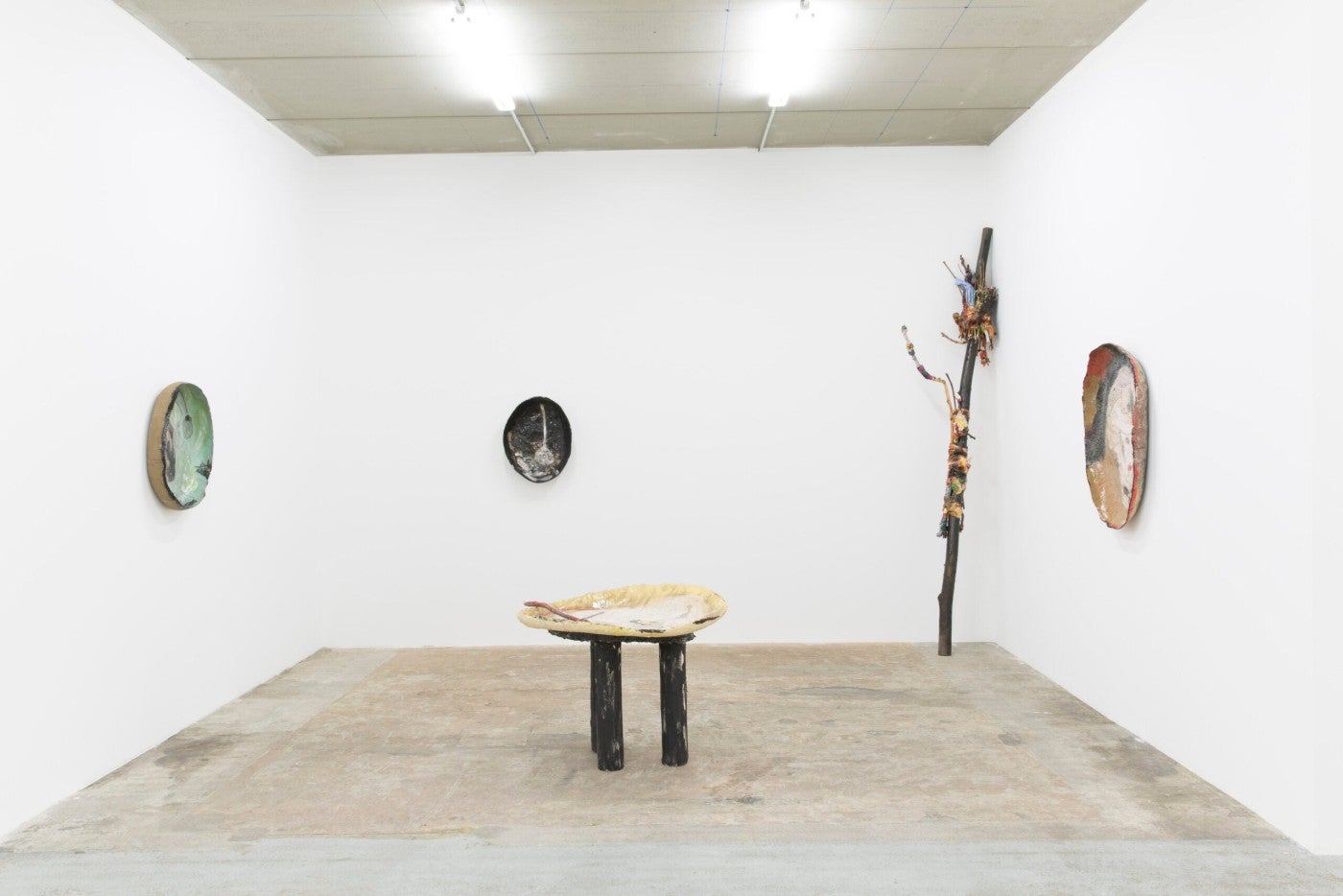LES CAMBUSES

A solo exhibition of Sylvie Auvray.
Sylvie Auvray Les Cambuses September 10th – October 19th, 2019
“Les Cambuses” (the lazarettos) is the title that Sylvie Auvray chose for her book and exhibition. Temporary sheds workers build near the construction sites of new highways, these lazarettos often turn into villages and permanent homes, like it was the case for Sylvie’s family in Corrèze. It was where she used to spend her summers making assemblies as a child. This is also how she calls her studio today: the lazaretto. Near the highway, on the ground floor of a building located Porte d’Orléans in Paris, Sylvie is working hard to awaken sleeping figures from the materials she sculpts. There, she surrounds herself with all sorts of objects: old anthropomorphic tools, Japanese Geisha paper masks and cult objects from the Hopi tribe found in the flea market of Vanves. These folkloric and mythological objects and images are the source of inspiration for the forms she creates, all very mischievously provocative, impertinent or simply playful.
Walking through the anteroom of the exhibition: Under the heat wave, the fan is gently stirring the strings of a blue Gingham fabric apron hung upside down and pulled by a shapeless cast of dry plaster on which she has hastily wrote “JUICE” with her finger. Near the inscription, two stains coming from the bottom of an unlabeled bottle of chemicals she has emptied there, just to see what was inside. When spilled out, the viscous substance generously waddled. It rejoiced Sylvie, who in turn waddled too, captivated by the undulations of the material. She still has those childlike responses, receptive to the lively aspect of moving matter. When drying times are too long or the kilns too small, she uses plaster and car paint in place of clay and enamel. She relates to those materials because they capture her fleeting gestures and the marks of her haste. The artist needs uncertainty to give life to her lively shapes: plaster and adrenalin, clay and adrenalin, enamels and adrenalin.
Juggling between her kilns, which temperature rises up to 1 300°C, she leaves in the constant fear of blowing the heavy or light gas pockets left by the vapors of the pink spray paint she uses to enhance her blistered pedestals. Behind the kiln door is a foaming flow of hot swollen metal, an expansive melt of screws and porcelain. Sylvie likes to fire everything to see how it resists, transforms or breaks. Besides, she often recycles, bargain-hunts and repurposes: a passion for old things found in old houses. She does the same with her broken or just started sculptures, gathering bits and pieces into piles she ends up bundling up on three-meter long branches. These bundles of sticks become like ghosts, dispossessed or repossessed fortune-telling sticks that end up drown in paint. Pieces of crates, fabric laces, twigs, old ceramic strips: emotionally-charged objects she collects and recycles when they are nothing more than melancholic items. She integrates them into her works to revive them. This is how she broke her plaster painting into three parts to make an awkwardly majestic pedestal resembling the drapery of an antique Venus who had let her gown drip.
Tired of working bended on the floor, the artist has built rickety stools with angular legs and no knees on which she cannot seat anyway. They are pedestals for now, but after the firing, they might become sculptures, or wobbly props for the dirty tricks of some of her crazy toons. All around her studio are pots on the edges of which are printed the start of cartoony narratives: loose vignettes or onomatopoeias found in a special edition of Scrooge McDuck. Her pots are like the edges of a hole on the slip of which she has hastily drawn while it’s not hard but soft enough, before it was too late. Sylvie loves the idea that people can eat in her paintings. She turns them into giant plates with oversized forks, both too fragile and heavy, unable to grab anything. Her restless paintings stretch their edges as if they were arms, thus opening an immersive and rounded space where advertising slogans caught on the back of American trucks driving on the I5 or 1455 highway get bogged down: Joe the happy plumbber, we don’t drug our chicken, the cherry and the bee. In the same way that Sylvie’s plates turn into paintings, her brooms become sculptures. They only need a corner really, no pedestal. Erected entities, waiting or pending. In a corner stand punished the young dancers of Degas who quit ballet to wear skirts made out of straw, flax yarns and turkey feathers, and who turned into witches and sticks. Sylvie’s brooms might also have swallowed Legba, a voodoo deity from the African Gold Cost, compared to the devil by some early century anthropologists. Legba is said to discreetly move objects around to bring back chaos.
Sylvie tirelessly manipulates forms she is afraid of winding or killing, but leaves on their own once revived and rescued. Like Sylva, a Middle-Age allegory of a boundless and wild raw material, Sylvie’s electric pieces bend and twist in search of a definite, harmonious and proper shape. But they remain in a perpetual crisis of generous proliferation, eventually contaminating us.
Sarah Holveck
Born in 1974, Sylvie Auvray graduated from the National school of fine arts in Montpellier in 1993 and from the City & Guilds London Art School in 1996. She recently exhibited at the Chinati Foundation in Marfa Texas after her residency there, at the MAMVP, Paris ; Mamco, Geneva ; FRAC Champagne Ardenne ; Consortium, Dijon ; Dairy Art Center, London ; Musée d’art moderne Grand-duc Jean, Luxemburg ; Centre Pompidou, Paris ; Centre d’art contemporain Circuit, Lausanne ; Palais de Tokyo, Paris. Lately in residency at the California State University, in Long Beach, she created the big ceramics of this exhibition.